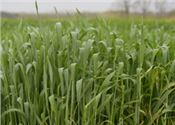|

Wheat breaks dormancy at the R. R. Foil Plant Science Research Center at Mississippi State
University March 29, 2017. Decreasing wheat acreage is a nationwide trend, as poor commodity
prices relative to other row crops have led producers to consider other options.
Photo by MSU Extension Service/Kevin Hudson
STARKVILLE, MISS.
2017 marked a 54-year low for wheat acreage in Mississippi, and 2018 is not much better. The U.S. Department of Agriculture reports an estimated 50,000 acres in winter wheat for 2018, an increase of 11 percent. Production dropped to 45,000 acres last year, just three years after wheat growers planted 230,000 acres in 2014.
Erick Larson, grain crop specialist with the Mississippi State University Extension Service, said decreasing wheat acreage is a nationwide trend, as poor commodity prices relative to other row crops have led producers to consider other options.
“Wheat is not offering the same amount of profitability as summer row crops like corn, soybeans and cotton in the last couple of years,” he said. “Our climate is more conducive to summer crops, and we have plentiful rainfall. Wheat is mainly grown as a primary crop in regions much drier than Mississippi, where rainfall is extremely limited for summer crops and growers can’t maintain the level of productivity that they would like.”
Extension agricultural economist Brian Williams said cash wheat prices were $4.35 a bushel as of late March, up 47 cents from a year before. July wheat futures were trading at $4.81.
“Although wheat is down from its early March highs, things are looking much better than a year ago at this time,” Williams said. “The big thing to watch going forward is what the crop will look like this spring. We have more acreage nationally, but the big question is what yields will look like. That will likely be a major market driver this spring and early summer.”
One of the few winter crops grown in Mississippi, wheat is planted in mid-fall. The crop grows moderately before it goes dormant at a relatively immature stage over the course of winter.
During dormancy, the crop is equipped to withstand the freezing precipitation and abnormally low temperatures common in January. In spring, wheat breaks dormancy and starts growing upright before heading in late April and early May. Grain matures in late May to early June and is harvested quickly thereafter.
“In early- to mid-April, the reproductive organs of wheat plants are more vulnerable, particularly after heading,” Larson said. “So, a freezing event early in the spring can be very damaging.”
Another reason for wheat acreage declining in Mississippi is poor planting conditions.
“It has been exceptionally dry in the last two seasons, beginning in early September and lasting through wheat planting time in October, where soil moisture has been very short in the top couple of inches,” Larson said. “Wheat is seeded fairly shallow also, so having extremely dry conditions over an extended time period has restricted wheat plantings.”
Patrick Poindexter, MSU Extension coordinator in Alcorn County, said wheat in the northeast corner of the state appeared to be of good quality, though it is still in a vegetative stage.
“We have good looking wheat so far, and we haven’t had to deal with much disease pressure, but we are probably 10-14 days behind counties south of us,” he said. “Some of our fields are taller than 4 inches, while some are a little shorter than that because of all the rain we’ve received.” ∆
|
|